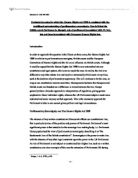'The Human Rights Act 1998 was no doubt intended to strengthen the rule of law but not to inaugurate the rule of lawyers.' (R(Alconbury Developments Ltd) v. Secretary of state for the Environment, Transport and the Regions (2001) Lord Hoffmann. Discuss.
‘The Human Rights Act 1998 was no doubt intended to strengthen the rule of law but not to inaugurate the rule of lawyers.’ (R(Alconbury Developments Ltd) v. Secretary of state for the Environment, Transport and the Regions (2001) Lord Hoffmann. Discuss. In administrative law, has the act had the effect that Lord Hoffmann suggests it was intended to have?
What lies behind the concept of ‘rule of law’ is a debatable issue. So how is one to know what precisely was intended to be strengthened by the introduction of the HRA 1998? In the context of Alconbury , Lord Hoffmann was using the ‘rule of law’ to symbolise the constitutional order and the role of the courts within it. By contrasting the rule of lawyers, he was meaning to say that the courts are aware that the HRA was not intended to allow them to get politically involved and substitute their own decisions for that of public bodies. This idea of courts upholding the rule of law is reminiscent of the modified ultra vires theoretical justification for judicial review (courts are upholding the rule of law, because that is what Parliament intends). Yet, albeit not intended to give a new constitutional status to the courts, it is questionable how far the powers given to them when reviewing administrative acts and legislation involving human rights were intended to extend.
In relation to legislation, a so called ‘soft’ form of constitutional review has been adopted. Under s. 3 of the HRA the courts have an interpretative obligation. They must ‘so far as it is possible to do so’ read and effect to primary and secondary legislation in a way which is compatible with the Convention rights. In comparison to jurisdictions where courts are allowed to invalidate legislation which is incompatible with human right (Bill of Rights), the English courts are only allowed to issue a declaration of incompatibility under s 4 HRA. This however should happen only rarely if one is to follow the interpretation given to s.3 by Marshall. He explains that there is a two stage approach to legislative interpretation in light of the section. Firstly, the courts must ‘read’ the provision. To be able to read it as being incompatible the court must find an unambiguous incompatibility with human right. But even so, the courts have to consider whether the relevant Act cannot be ‘given effect’ which complies with the Convention. This involves finding a justifiable limitation to the right- for example social need or public order. If no limitation is applicable only then would the courts issue a declaration of incompatibility. Case law demonstrates how courts have read in and down legislation in order to give it a compatible meaning. R v A demonstrates the different views on how this should be done. While Lord Steyn is more adventurous, the more cautious view of Lord Hope seems to have been adopted. In this respect, the courts would not try to legislate, but merely interpret. But does this ‘interpretation’, means linguistically straining words it is not quite clear? Another way in which the courts would refuse to issue a declaration of incompatibility is demonstrated in- Re S. In latter case, the courts did not wish to interfere with the wide discretionary power given under the Children Act 1989, but preferred to see themselves as adjudicators when the case comes to review the exercise of that discretion. On other occasions the judges have not felt restrained from issuing a declaration of incompatibility. In International Transport Roth GmbH the Immigration and Asylum Act 1999, which fixed penalties for hauliers who allowed persons to gain illicit entry to the UK, was held to be incompatible with the Convention. But even when the rare occasion occurs and a declaration is issue the constitutional order is not offended. The legislation goes back to the Minister responsible; who may amend it so that it is complies with the Convention s.10. In this way parliamentary supremacy is preserved. But as seen above it is only preserved in as much as courts would refuse to read in/down legislation or substitute their own interpretation of legislation. In this respect the less the declarations are made, the more likely it is that the rule of lawyers reigns or simply that legislation is compatible after all.







